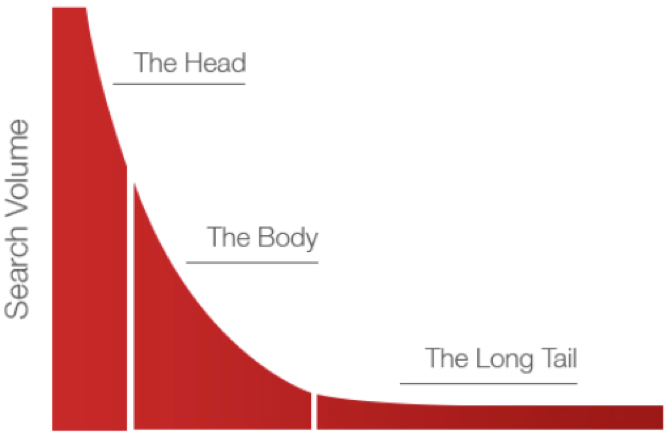The Long Tail
If you plot every search query on a graph in order of popularity, starting with the most-searched on the left, you’ll have a picture that looks something like this. On the left, a few really popular queries most likely relate to your top-selling items. We call this “the head.” Then there’s a sharp drop off before the next section, “the body,” where maybe twice as many queries appear half to a third as many times. And then you’ll have everything else: the tail.
It’s tempting to write off these tail queries as meaningless junk, and concentrate all your efforts on making sure your search is delivering top-notch results for the more popular queries. That’s where the biggest returns are, right?
Not necessarily. Taken on a case-by-case basis, tail queries might not seem important. But in aggregate, they could add up to almost half your total queries. What’s more, they’re likely to give you important insights into sales you’re missing—that’s the goldmine.
On the left, a few really popular queries most likely relate to your top-selling items. We call this “the head.” Then there’s a sharp drop off before the next section, “the body,” where maybe twice as many queries appear half to a third as many times. And then you’ll have everything else: the tail.
It’s tempting to write off these tail queries as meaningless junk, and concentrate all your efforts on making sure your search is delivering top-notch results for the more popular queries. That’s where the biggest returns are, right?
Not necessarily. Taken on a case-by-case basis, tail queries might not seem important. But in aggregate, they could add up to almost half your total queries. What’s more, they’re likely to give you important insights into sales you’re missing—that’s the goldmine.
Specific Queries
One category of things we usually find in the tail is long, specific queries. For example, a site that sells computers may have a lot of queries for “laptop,” and relatively few for “Lenovo ThinkPad X1 Carbon.” These long queries happen less frequently, but they also show a higher intent to buy, and they convert at a higher rate. When people are looking for a Lenovo ThinkPad X1 Carbon, they have likely already done some research, and have either already decided what they’re going to buy, or are very close to it. Does your search engine take these customers where they want to go? Many search engines don’t. To capture these sales, regularly monitor your tail query data to learn what terms people are using, and teach your search engine to return the right results.“Inventory Enhancement” Opportunities
Another insight you’ll get from your tail queries is visibility into items that people would like to buy from you, but that you don’t sell. Your site’s search box is oftentimes the first place you’ll see shoppers asking for new products. Your tail queries can tell you what consumers are looking to purchase months faster than a clinical focus group. For example, a tire retailer may have tail queries for windshield wipers, headlight replacement bulbs, mud flaps and other auto parts. These queries represent opportunities for growth. They tell you that your brand is strong enough that people are looking to you for more. If there are sufficient queries for specific items, you may consider enhancing your inventory or establishing partnerships to meet those expectations.Misspellings and Abbreviations
Misspellings, alternate spellings and abbreviations also make up a lot of tail queries. Luckily, we all survived elementary school, and don’t have to take spelling tests anymore! So, don’t punish these “mistakes.” You want your site to understand simple typos, abbreviations and spelling variations. For example, if British people search for a “grey” T-shirt instead of the “gray” T-shirt listed on your American e-commerce site, will your search engine direct to them to the right page? When people type in “caulifowler,” will they still get their vegetables? Don’t ignore these kinds of queries. Capture the conversions they represent by training your search engine to connect common misspellings, alternate spellings and abbreviations to products on your site. Taken in aggregate, the potential sales can add up to some pretty significant numbers.Usability Issues
Tail queries can also highlight ways that your website confuses people. Recently, an analysis I did for a client contained a bunch of seemingly random numbers in its tail queries. They were all five numerals long. A quick look at the client’s homepage revealed that the search box was right next to another feature that helps customers find the nearest store. As it turns out, people were mistakenly entering their zip codes in the search box. Those numbers added up to a full five percent of the site’s total queries! Luckily, it was an easy fix. Little things like this can frustrate customers enough to send them to a competitor’s page. Your tail queries can shine a spotlight on them.What’s Your Tail Telling You?
The great thing about your tail queries and your search query data in general is that it can tell you a lot about how people are using your website, and how well you’re serving them. And don’t forget, you’re getting all these data points for free, in real-time, from the people who are already using your site. They’re providing more accurate, timely and cost-effective data than any survey or focus group can produce. The problem is that the tail is so large and so disparate, it’s difficult to know where to start, and hard to wrap your head around. A search improvement solution can help. It can go through all your tail queries and categorize them, giving you insights into what’s happening when your customers use your search engine. A good search solution will evaluate how well your search is performing, help you understand your tail query data and provide guidance on how to fix the issues that are preventing you from selling more. The solution should pay for itself with the corresponding increase in your eCommerce conversion rate. What’s your tail telling you? You’ll never know until you look. The bottom line is this: If you’re not actively monitoring your tail query data, you’re ignoring valuable information and letting easy sales walk out the door.Contact us here to learn more about how Appen can help improve your conversion rates based on your tail query data and other important insights.











